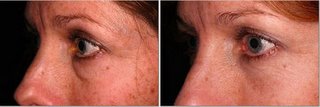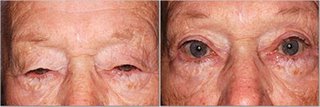A consultation is mainly a time for communication between the patient and surgeon. The patient m ust be given time to express what is bothersome. For example, a patient may have hanging and excessive upper eyelids, bags under their eyes, and droopy eyebrows. From the patient’s perspective, it may only be the upper eyelids that are bothersome. Dr. Ebroon feels very strongly that a patient should only work to address what is bothersome to them.
ust be given time to express what is bothersome. For example, a patient may have hanging and excessive upper eyelids, bags under their eyes, and droopy eyebrows. From the patient’s perspective, it may only be the upper eyelids that are bothersome. Dr. Ebroon feels very strongly that a patient should only work to address what is bothersome to them.
After listening to the patient’s concerns it is time to review the medical history. What other medical conditions does the patient have? What surgeries has she had in the past? Does she have any particular eye conditions? Is she allergic to medications? What family history exists? Does the patient smoke? What else is going on medically?
Once these questions are answered, then Dr. Ebroon can perform a comprehensive examination of the eyes, eyelids, and face. This includes taking vision, taking ten separate measurements of the eyelids, assessing for dry eye with two different dry eye tests, looking at the eye with a microscope, assessing the position and strength of the eyelids, checking for droopy eyelids, measuring eyebrow position, looking for normal eye reflexes, testing the nerves around the eyes, and taking eyelid photographs.
Once the physical examination is completed, Dr. Ebroon can give his recommendations. He discusses what surgical technique he would advise, if any. He also discusses any special circumstances of the surgery given a patient’s unique medical history and physical examination. For example, a patient with dry eyes might be told that their surgery needs to be more conservative so as not to exacerbate the dryness.
circumstances of the surgery given a patient’s unique medical history and physical examination. For example, a patient with dry eyes might be told that their surgery needs to be more conservative so as not to exacerbate the dryness.
Finally, Dr. Ebroon tries to answer any remaining questions. He tries to anticipate common questions that are asked during the consultation. Nevertheless, patients always have unique concerns that are best addressed at this point after a thorough history and physical examination. Dr. Ebroon recognizes that patients feel much more comfortable when they have been given enough time to ask questions.
Patients meet Dianne, Dr. Ebroon’s surgical coordinator, after the consultation is completed. Dianne is happy to review “before and after” pictures of other patients who have had surgery. (These pictures are all from patients who have given our office permission to show their pictures to others.) It can be quite helpful to see examples of others who have benefited from blepharoplasty.
Dianne can also go over possible surgical dates. Dr. Ebroon performs most of his surgery on Fridays so that patients can incorporate the weekend into the healing process. Dr. Ebroon’s surgical schedule is often booked for a at least a few weeks. Sometimes a cancellation will open up a sooner date.








 hat affects healing time? Some factors that affect healing are which procedures are performed, how easily the patient bruises, how well the eyelids are taken care of during the postoperative period, and how good of a healer the patient is.
hat affects healing time? Some factors that affect healing are which procedures are performed, how easily the patient bruises, how well the eyelids are taken care of during the postoperative period, and how good of a healer the patient is. ust be given time to express what is bothersome. For example, a patient may have hanging and excessive upper eyelids, bags under their eyes, and droopy eyebrows. From the patient’s perspective, it may only be the upper eyelids that are bothersome. Dr. Ebroon feels very strongly that a patient should only work to address what is bothersome to them.
ust be given time to express what is bothersome. For example, a patient may have hanging and excessive upper eyelids, bags under their eyes, and droopy eyebrows. From the patient’s perspective, it may only be the upper eyelids that are bothersome. Dr. Ebroon feels very strongly that a patient should only work to address what is bothersome to them. circumstances of the surgery given a patient’s unique medical history and physical examination. For example, a patient with dry eyes might be told that their surgery needs to be more conservative so as not to exacerbate the dryness.
circumstances of the surgery given a patient’s unique medical history and physical examination. For example, a patient with dry eyes might be told that their surgery needs to be more conservative so as not to exacerbate the dryness.

 tential risks. The most dangerous complication from surgery is excessive bleeding after the surgery. The nerve that is responsible for eyesight could be potentially squeezed by excess blood and cause permanent loss of vision. By stopping any blood thinning medications two weeks prior to surgery the chances of such a problem are greatly diminished. Other potential risks of surgery include double vision, dry eyes, infection, a retracted or pulled down eyelid, asymmetry, undercorrection, overcorrection, and the need for more surgery. A brow lift has its own unique set of complications. These include tenderness along the hairline and weakness of the facial nerve. Fortunately, with good surgical technique such problems are rare.
tential risks. The most dangerous complication from surgery is excessive bleeding after the surgery. The nerve that is responsible for eyesight could be potentially squeezed by excess blood and cause permanent loss of vision. By stopping any blood thinning medications two weeks prior to surgery the chances of such a problem are greatly diminished. Other potential risks of surgery include double vision, dry eyes, infection, a retracted or pulled down eyelid, asymmetry, undercorrection, overcorrection, and the need for more surgery. A brow lift has its own unique set of complications. These include tenderness along the hairline and weakness of the facial nerve. Fortunately, with good surgical technique such problems are rare.